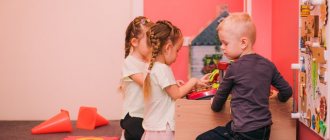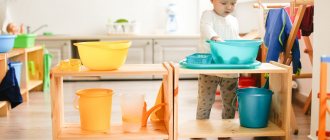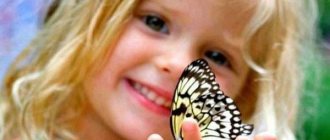The role of cultural and hygienic skills in the education of children of primary preschool age
Everyone knows that the health of the human body begins in early childhood. The child's body is especially sensitive to environmental influences. A person's health will depend on how favorable or unfavorable these influences are. Hygienic training and education of a child is the basis for strengthening and protecting his health. There are three main categories of raising a child: hygiene skills, cultural behavior skills and self-care skills.
Hygienic education is part of the general education of the child, and hygienic skills are an integral part of cultural behavior. Instilling hygiene skills in children is the responsibility of parents.
A favorable family atmosphere contributes to the good development of cultural and hygienic skills in children. Human qualities such as respect, tact, sensitivity, and delicacy towards others must be instilled in a child from early childhood, when he just began to speak and listen to adults. In addition, from an early age it is necessary to instill the skills of cultural behavior at a party, indoors, outdoors, in transport, in nature. From an early age, a child must learn that a cultured person always and everywhere (even at home) observes the basic norms and rules of behavior, that the basis of politeness is goodwill and a sense of proportion, which determines what can be done and what cannot be done. This also applies to hygiene skills.
The child's relationship with the social world begins to take shape as basic skills and habits are formed. This happens in the second year of a child’s life. At this age, children perceive quite negatively any changes in their environment (moving furniture in their room, the absence of any toys). They show dissatisfaction when they see someone taking their toy or, on the contrary, giving it to another child. In no case can such behavior be called greed or whim, since this is a long-formed habit of seeing one’s own objects in their places. For a child, surrounding objects help to navigate, which is not entirely easy for a small child. Therefore, the established “children’s” world should not be disturbed, but on the contrary, parents should try to make it more vibrant and interesting for the child. Violation of the child’s established living conditions (daily routine, feeding or cooking conditions) can lead to negative consequences, namely, disruption of the child’s mental and emotional state. Therefore, the most important habit formed in a child of the second year of life is adherence to the regime.
From the first days of life, when developing cultural and hygienic skills, there is not a simple assimilation of rules and norms of behavior, but an extremely important process of socialization, humanization of the baby, and his “entry” into the world of adults. Early childhood is a sensitive period for the initial formation of cultural and hygienic skills.
The beginning of the formation of cultural and hygienic skills coincides with the formation of objective activity. By handling personal hygiene items, the child’s sensory experience expands, he becomes familiar with the world around him, and his cognitive needs are fulfilled. The child learns the functions and qualities of objects. By feeling, stroking, examining, sniffing, biting, he discovers their distinctive features and this evokes bright positive emotions in him. There is a development of cognitive feelings: surprise, joy, pleasure from learning new things. In the process of learning the qualities of objects and substances, they are reinforced by words. This makes cognition conscious, concepts are consolidated in the child’s memory, and vocabulary is enriched. When performing various everyday activities, the child learns to observe, compare, analyze, and establish cause-and-effect relationships. As they are mastered, cultural and hygienic skills are generalized, separated from the corresponding subject and transferred to a playful, imaginary situation.
Cultural and hygienic skills underlie the first type of work activity available to a child—self-care work. Self-service is characterized by the fact that the child’s actions do not have a social motive (to do something for another), they are aimed at himself. Based on self-service work, at the age of three, elementary household activities begin to appear, which at an older age develop into collective household labor.
Mastering cultural and hygienic skills affects not only play and work activities, but also the child’s relationships with adults and peers. He strives to show adults what he has learned and expects support and approval from them. He tries to teach his peer to perform a specific action correctly, gives him instructions, teaches him.
Performing cultural and hygienic actions gives the child the opportunity to compare himself with other children: he performs the action better or worse. Thus, by comparing oneself with others, the prerequisites are formed for the formation of self-esteem, awareness of one’s capabilities and skills, as well as prerequisites for self-control. Children develop such a new personal formation as awareness of their “I”.
"Good or bad?"
Goal: to develop the ability to behave correctly in society, to comply with cultural and hygienic standards; learn to assess the current situation, analyze the actions of others; develop the concept of cultural behavior.
The teacher shows children plot illustrations depicting various situations. For example, the picture shows how a child throws toys around, brushes his teeth, helps an elderly person climb the stairs, etc. Preschoolers should determine and justify the answer about which situation is positive and which is negative.
- "Feeding the doll."
Goal: to teach the simplest actions with story toys (feeding), to instill hygiene skills; cause speech activity; cultivate good feelings towards the doll.
Methods for developing cultural and hygienic skills in families
In preschool kindergartens, increased attention is paid to developing cultural and hygienic skills in preschoolers. Moreover, program requirements have been developed for each age category of children. Preschoolers are taught to understand the value of a healthy lifestyle, are told about the basic rules of safe behavior, and are taught to take care of their health. According to the program “From birth to school”, ed. N. E. Veraksa, when working with younger preschoolers, the task of hygiene education is to instill cultural and hygienic skills. Among them are neatness in everyday life, neatness in clothing, teaching basic etiquette for eating as an integral part of a culture of behavior. To make it easier for your child to learn new skills, you should make it fun and interesting.
- Continue teaching your child to wash their hands before eating or if they are dirty (first under the constant supervision of an adult, and then independently). The child is taught to dry his face and hands with a personal towel.
- Teach a preschooler to put himself in order, turning to the help of an adult when necessary. Work on developing the skill of using individual objects, such as napkins, a handkerchief, a pot, a comb.
- While eating, encourage children to act independently and teach them to hold a spoon in their right hand.
- When dressing and undressing, remind children of the procedure. With a little help from an adult, you need to teach the child to take off shoes and clothes (unzip the front, buttons, Velcro fasteners). The child must be explained how to fold his clothes correctly when undressing. He is shown how to put on shoes and clothes correctly.
Second younger group (children aged 3-4 years).
- Teach children to pay attention to their appearance. When washing their hands, remind them how to use soap. Continue teaching them to wash their hands, ears, face; Wipe your hands and face dry after washing, hang a towel in the designated area, use a handkerchief and comb.
- Develop behavioral skills when eating: correctly use a spoon and teaspoon, fork, napkin; do not play with bread, chew food with your mouth closed, do not talk if there is food in your mouth.
- By the end of the school year, children should master the simplest skills of behavior while eating and washing.
Cultural-hygienic skills and self-service skills gradually become more complex with age and their volume increases. Children become more independent. In kindergarten, an environment should be created that is conducive to the development of personal hygiene skills, especially for young children. In the daily routine of young children, more time is allocated than in the daily regimen of middle-aged children for the formation of cultural and hygienic skills. Previously acquired skills are consolidated and improved. For example, in the first younger group, the child washes his hands before eating with a reminder and with the help of adults, and in the older group he can help a friend, etc.
The main methods of developing cultural and hygienic skills in preschoolers: personal example of significant adults; educational activities in this direction; demonstration of necessary actions; explanation; explanation; encouragement; repetition of actions; didactic games; conversations; poems; proverbs, sayings; nursery rhymes; quizzes, entertainment; gaming techniques; multiple repetition.
Interesting stories, poems, and pictures are of great importance for consolidating cultural and hygienic skills.
Children of preschool age mainly possess concrete, visual-figurative thinking. Therefore, in order to successfully develop their hygiene skills, one should more often resort to demonstrations, which are accompanied by explanations. The teacher shows how to hold a spoon correctly, leave the table, and wash your hands. The demonstration is accompanied by an explanation. Gradually, children perceive the appropriateness of the teacher’s demands (wash their hands until they are clean, pour water on the floor, etc.). The teacher shows any action in such a way as to highlight individual operations. First, he focuses children's attention on the most significant actions, and then on additional ones. Operations follow each other in strict order with an interval between them of no more than 5-10 s. Otherwise, it is not possible to develop a dynamic stereotype. Showing actions to children must be accompanied by pronunciation. Skillful guidance on the part of the teacher reduces the time it takes for a child to master personal hygiene skills.
The example of a teacher can be direct or indirect. In the case of a direct example, the teacher invites the children to watch what he does, and in the second, he uses various forms that arouse children’s interest and attract their attention. If the teacher’s behavior serves as an example, his personal attitude must necessarily manifest itself. Only in this case will the example be convincing for children.
In all groups, techniques such as praise, approval, encouragement, and pedagogical evaluation are widely used. Timely praise is always important, but it should not be abused. Otherwise, the child will constantly wait for praise. Fulfilling the demands of adults should become the norm of behavior for children, their need. Approval encourages children to continue to do the same, to do something even better. Sometimes the teacher encourages the child in such a way as to remind him of the rules of execution. Sometimes he has to use censure, but this pedagogical technique is best used in an indirect form, without naming the child's name.
Pedagogical assessment, or a teacher’s positive (negative) judgment about the child’s individual actions and behavior.
A positive assessment of a child can be given in cases where it is necessary to emphasize his achievement of certain successes in the process of mastering new skills. For example, if a three-year-old child put on a shirt on his own, or was able to fasten a button, the teacher approves of him. In order for the child to better understand his new skills, the teacher compares his present actions with the past, the new assessment of his actions with the previous assessment. A positive assessment must also be given in cases where children themselves understand how to act. Timely praise accelerates the development of the necessary skill. For example, a teacher may say: “I didn’t remind Gala that she needed to fold her blouse, but she folded everything herself. Well done!" The assessment can be given in front of the whole group, especially if all the other children also need to master the skill. If the majority of children in the group have already mastered this skill, and only some children are lagging behind, the teacher must approve the child individually.


